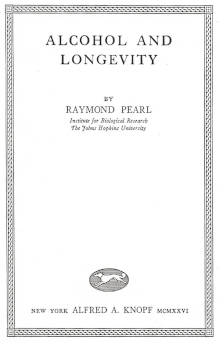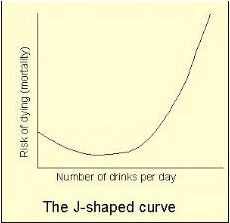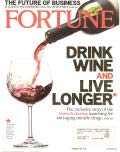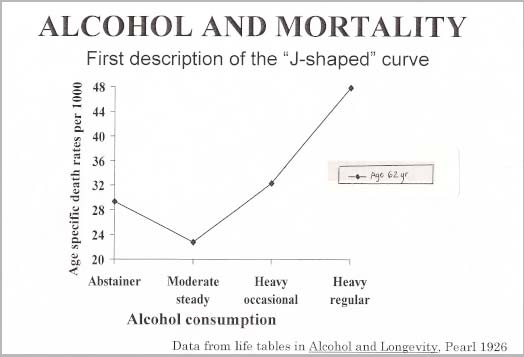Wine is Good News for Health in 2008

There were a large number of studies published in 2008 that continue to
document the health benefits of moderate wine consumption. The modern wine
industry cannot tout these findings to the public in part because of events
that transpired back in 1991. That was the year that Morley Safer ran a
televised feature on 60 Minutes about The French Paradox. Safer was a
Francophile and his neighbor was the French-born chef, Jacque Pépin.
Pepin reportedly told him that the French had a very low rate of
cardiovascular disease and Safer consulted with Curtis Ellison, M.D.,
Professor of Preventive Medicine and Epidemiology at Boston University
School of Medicine. Ellison told him the French secret was wine, food and
lifestyle. Although the French consumed a diet high in saturated fat,
smoked more, and exercised less than Americans, the French had 40%
fewer heart attacks and lived on average about two and a half years
longer. To their advantage, the French consumed moderate amounts of
red wine regularly with meals, they ate more fresh fruit and vegetables,
they took longer to eat meals and snacked less, they ate less red meat
and more cheese, and they used more olive oil and less lard or butter in
their cuisine. Ellison told Safer that of all these factors, the link between
moderate and regular consumption of wine with meals was strongest and
supported by the most scientific evidence.
French researcher, Serge Renaud, M.D., PhD, working at the French National Institute for Health, had found a
relationship between the low rate of cardiovascular disease and moderate wine intake in the French population
and supported Ellison’s beliefs. On the now famous French Paradox telecast which aired on November 17,
1991, Safer asked Renaud to what he would attribute the observed decreased mortality from cardiovascular
disease among the French. Renaud answered, “I think it is the alcohol.” Safer ended the show holding up a
glass of red wine. The next day, the demand for red wine took off. Within a few weeks after the program aired,
sales of red wine in the United States, which had been stagnant, shot up 40%. Gallo Winery had to put their
leading seller, Hearty Burgundy, on allocation.

This was a seminal event that piqued the public’s interest about the possible health benefits of wine but also
set off a controversy. Winemakers like Robert Mondavi and others wanted to promote the health benefits of
wine following this 1991 telecast, but the U.S. Bureau of Alcohol, Tobacco and Firearms
(B.A.T.F.) blocked all attempts to do this. The B.A.T.F. even challenged Renaud to show
them his data. It was unlawful to make any health claims for wine on wine labels or in wine
advertising. The Wine Institute, which is a California organization composed of wineries
and affiliated business, sided with the B.A.T.F. and strongly advised against any publicity
proclaiming wine a healthy drink. To this day, the Wine Institute, follows the 2005
guidelines of the U.S. Departments of Agriculture and Health and Human Services that
state, “The consumption of alcohol can have beneficial or harmful effects depending on
the amount consumed, age and other characteristics of the person consuming the alcohol
and specifics of the situation and with the guidelines’ caution against excessive
consumption and its assertion that there are some individuals who should not drink.” The Wine Institute
discourages member wineries from promoting the health benefits of wine. Currently, federal money cannot be
used to support alcohol research other than treatment and addiction and funding is only available for viticultural
studies and examination of grapes, raisins and other non-vinification topics. The United Kingdom-based Alcohol in Moderation (AIM) and The Desert Heart Foundation and its associated doctor support group, the Reynaud
Society, are among the few voices that are promoting the truth about the responsible consumption of alcohol,
and particularly wine, to the public.
Serge Renaud published his now famous paper in the medical journal, The Lancet on June 20, 1992. Titled
“Wine, alcohol, platelets and the French paradox for coronary heart disease.” Renaud’s study involved 34.000
middle-aged men living in eastern France. In this paper, he emphasized, “At the moderate intake of alcohol
associated with the prevention of coronary heart disease, the mechanism of protection seems to be at least
partly, a hemostatic effect, possibly a decrease in platelet reactivity.” It soon became clear to Renaud and
other researchers that the French paradox was also explained by polyphenols present in wine.

The first report of the beneficial effect of moderate alcohol consumption and of the
relationship between alcohol intake and mortality dates to 1926 when biologist
Raymond Pearl presented his well-researched statistical data regarding the effect of
alcohol on longevity. Pearl was investigating the effects of alcohol on chicken
progeny at the Institute for Biological Research at The Johns Hopkins University,
when he discovered that, “Alcoholized fowls lived longer than those who got nothing
but plain food and water.” He later collected information on a large group of white,
working class people, ages 15 to 99 years, in Baltimore, Maryland, studying the
factors involved in the etiology of tuberculosis but including the alcohol intake of the
study individuals. His conclusion, published in 1926 in the book Alcohol and
Longevity, was, “In a fairly large and homogeneous sample of the working class
population of Baltimore, the moderate drinking of alcoholic beverages did not
shorten life. On the contrary moderate steady drinkers exhibited somewhat lower
rates of mortality, and greater expectation of life than did abstainers. Those
persons in this experience who were heavy drinkers of alcoholic beverages
exhibited considerably increased rates of mortality and diminished longevity, as
compared with abstainers or moderate drinkers.”
Since Pearl’s book was published at a time when temperance sentiment was rampant, it was no wonder that it was
heavily criticized. As a nod to the tone of sentiment of the time, Pearl notes in his conclusion, “But it certainly
gives no support to the almost universal belief that alcohol always shortens life, even in moderate quantities.”
He also exclaims, “The results are unquestionably novel.”
Pearl’s carefully collected scientific data was presented in life tables in his book but the information clearly
validates the now well-known J-shaped curve relationship between daily alcohol intake and total mortality.
Pearl, himself, never published or described the J-shaped curve, but Ronald F. Unzelman, M.D., who wrote
about Pearl in the newsletter of the Wayward Tendrils, a society of wine book collectors, transferred one of the
age-specific death rate tables to a graph that he was kind enough to share with me (see below).
In the 1970s, Arthur Klatsky, M.D., working at Kaiser Permanente in Northern California, confirmed the Jshaped
curve. The composite alcohol-total mortality relationship shows the lowest risk among drinkers who
take less than 3 drinks per day. This curve has been validated by extensive epidemiological studies and holds
true for cardiovascular disease, some cancers, and cognitive dysfunction as well.

Most of the health benefits of wine have been attributed to alcohol and phenolic compounds found in the skin
and seeds of red grapes. Although many studies suggest it is the phenols in wine that give it superior health
benefits over other alcoholic beverages, this has not been completely proven. Phenols are found in all plants
and are known as phytoalexins or phytochemicals, compounds that have biological activity in the human body.
They are particularly abundant in fruits such as strawberries, blueberries, pomegranates and grapes, and
vegetables, grains, peanuts, green tea, coffee, olive oil and chocolate. Without getting too technical, there are
two categories of phenolic compounds: non-flavonoids and flavonoids. There are three classes of flavonoids:
flavanols, flavonols and anthocyanins. Reserveratrol is the best known anthocyanin and is found primarily in
the skin of red grapes where it is produced in response to stresses such as fungal infections. Flavonols are
only present in the outer layers of grapes and, like resveratrol, act as a sun screen, absorbing ultraviolet light.
Catechin is the most well known flavanol but the group also includes quercetin, proanthocyanidins and
condensed tannins.
Phenols contain at least one aromatic ring (six connected carbon atoms who share electrons) with polyphenols
having multiple rings. Polyphenols are antioxidative because they have a catechol group on the aromatic ring
that attracts oxygen-free radicals from other molecules. As a result, the polyphenols scavenge free radicals
removing them so they cannot oxidize other compounds. This antioxidant effect is at least partially responsible
for the observed cardioprotection and other health benefits of polyphenols.
Red wine in particular has high levels of polyphenols, but levels vary among different grape varieties and
vineyard locations. Pinot Noir and Cabernet Sauvignon have a high level of seed flavonols. One glass of red
wine has 200 mg of phenolic compounds compared to 40 mg for white wine, primarily due to the anthocyanins
present in the skin of red grapes. Some wines can have high polyphenol levels because of the region in which
the grapes are grown and the winemaking techniques employed. For example, resveratrol levels are
increased in red wines from Bodega Catena Zepata in Argentina where the vineyards are at a high altitude.
Presumably, the elevated concentration of polyphenols in the grapes develop as a protective response to the
intense ultraviolet light at the increased altitudes.
Much of the scientific research on wine polyphenols has focused on the so-called “miracle molecule,”
resveratrol. Most of this research has centered on mice and in vitro (outside the living organism) studies.
Resveratrol has been demonstrated to lower cholesterol, reduce inflammation, decrease pain, prevent hearing
loss, and increase the life expectancy of fruit flies, earthworms, mice and strains of yeast in the lab. It has also
been shown to protect against cancer, heart disease and diabetes mellitus. Resveratrol may turn out to have a
roll in the treatment of cancer as well. It is postulated by researchers that resveratrol works by making active
the SRT1 gene which in turn stimulates the formation of new mitochondria and improves functioning of existing
mitochondria in muscles and other tissues.

Sirtris Pharmaceuticals makes a laboratory-created form of resveratrol known as SRT501
that is being developed as a possible treatment for certain diseases such as MELAS
(mitochondrial myopathy, encephalopathy, lactic acidosis and stroke-like episodes). The
therapeutic effect of SRT501 is through the improvement in functioning of mitochondria in
cells. The drug may have applications in many diseases of aging which show impaired
mitochondrial activity in cells. In July, 2008, GlaxoSmithKline bought Sirtris
Pharmaceuticals for $720 million. SRT501 has been well publicized in the press.
Researchers at the Northwest Agricultural and Forestry University in Yangling, Shaani
Province, China (Plant Cell, Tissue and Organ Culture, October 2007), have genetically
engineered a super vine by supplying it with an extra gene from a wild Chinese vine. Vitus
pseudoreticulate has an unusual variant of the stilbene synthese gene which triggers resveratrol production.
This grape variety has six times more resveratrol than normal. The research team plans to make wine from the
genetically modified vine, although the main application is to bestow more resistance to fungus on vines.
The United States is projected to lead the world in volume of wine consumed by the year 2010. Appropriate
education of the public (and physicians) about regular, moderate and responsible drinking of wine could have a
highly beneficial effect on the health of this country. It is estimated that 71 million Americans have
cardiovascular disease, or 1 in 3, and cardiovascular disease is our country’s number one killer. A very large
amount of credible literature has accumulated in the last 25 years that supports that which educated observers
have sensed for a long time, namely, that wine in moderation is good for heart health. Hermann Smith-
Johannson, a cross-country skier who lived to the ripe age of 103 years said, “The secret to a long life is to
stay busy, get plenty of exercise and don’t drink too much. Then again, don’t drink too little.”
The actions of beneficial wine compounds are complex and poorly understood at this time. The effects on the
cardiovascular system alone are numerous including antioxidant actions (preventing oxidation of molecules
such as LDL or low-density lipoprotein, the so-called “bad cholesterol”), suppressing endothelin-1, a substance
produced by the lining of blood vessels that promotes atherosclerosis or hardening of the arteries, direct effects
such as increasing HDL or high-density lipoprotein, the so-called “good cholesterol,” and anti-thrombotic or
anticoagulation effects that reduce the “stickiness” of platelets. The beneficial effects of wine compounds reach
beyond cardioprotection and include reduction in carcinogenesis, improved cognitive function, favorable
metabolic changes and a number of other health-enhancing effects.
In the following pages, I will summarize peer-reviewed, scientific studies published in 2008 that contribute to
our current understanding of the roles that alcohol and particularly wine play in our health. The good news far
outweighed the bad news in favor of the health benefits of wine, but the importance of moderation in wine
intake cannot be overemphasized. Over drinking can lead to a number of health problems including sudden
death from high blood pressure, heart attack, cardiac arrhythmia or stroke, cardiac myopathy, cirrhosis of the
liver, acute alcoholic hepatitis, osteoporosis, chronic gastritis, irritable bowel syndrome, tremors, insomnia,
nightmares and night sweats, dementia, and cancer of the mouth pharynx, larynx, esophagus, stomach, liver,
colon and breast. You are better off not drinking at all than drinking too much. In addition, it is important to
emphasize that moderate intake of wine by itself is not a panacea. It is critical that wine be consumed regularly
with meals and that meals include vegetables and fruits, whole-grain foods, fish, lean meats, low-fat dairy
products, limited portions of saturated fat, trans-fat and cholesterol, minimal salt intake and no smoking.
Regular exercise and weight control are important as well as part of a healthy lifestyle.
For the purposes of understanding “moderate drinking,” which is frequently referenced in the following research
articles, a few definitions are in order. In the United States, a standard drink (or unit) contains 17.7 ml of
ethanol which is equivalent to 12 ounces of beer, 5 ounces of wine and a shot of 80-proof distilled spirits. A full
bottle of wine contains about 5 to 7 drinks depending on the alcohol percentage. To determine the number of
drinks in a bottle, multiple 750 ml by the alcohol percentage and divide by 17.7. For example, one drink from a
bottle of wine that is 13% alcohol will equal 750 ml x 0.13 = 97.50 divided by 17.7 = 5.5 drinks. A bottle of 16%
alcohol wine will contain 6.8 drinks or about 1 more drink than a bottle with 13% alcohol. The point is, alcohol
percentage does make a difference when you are looking to drink in moderation. The definition of levels of
drinking vary, but usually moderate drinking is defined as no more than 1 drink per day for women and 2 drinks
per day for men. Heavy drinking is defined as 3 or more drinks per day. Obviously, one would want to scale
back the volume of drinking when imbibing a wine with a higher alcohol percentage or reach for a lower alcohol
wine to insure that you stay within the confines of “moderation.”








